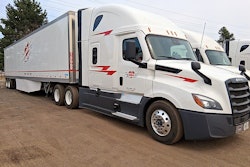American Sleep Apnea Association presented Schneider National with its first American
Sleep Apnea Award to commend the Green Bay, Wis.-based carrier for its detection and treatment program. Schneider accepted the award at the American Trucking Associations’ Safety and Human Resources National Conference and Exhibition in Pittsburgh.
Department of Transportation released $1 million in emergency relief funds to California to help pay for urgent repairs to roads and bridges damaged by wildfires. The funds will address repairs that needed immediate attention – such as damaged or destroyed guardrails, signs or traffic signals – until the state completes a full damage assessment.
Colorado is becoming more aggressive in its campaign to increase use of snow chains. An earlier snowstorm in late October gave state police their first chance to enforce a new chain law, which allows tickets ranging from $500 for failure to use chains to $1,000
for a failure to use chains that results in a lane closure. The state has spent almost $2.5 million to add new chain-up sites, as well as lighting and signage to existing areas.
Melton Truck Lines, based in Tulsa, Okla., said that it will make Iteris’ Lane Departure Warning system standard equipment on about 1,000 new trucks over the next three years.
The Department of Transportation’s Office of the Inspector General, in its audit of the National Driver Register, reported finding security issues and deficiencies with the data stored in the system. NDR, administered by the National Highway Traffic Safety Administration, is a central register that enables state department of motor vehicle officials to exchange information on problem drivers in each state, such as those convicted of driving under the influence of alcohol. The system is intended to help prevent problem drivers from obtaining a driver’s license to operate a vehicle, or being hired for safety-sensitive positions.
In 2006, state officials made more than 70 million inquiries for driver’s license applicants, 9 million of which were found in NDR. In all, 42 million problem drivers are recorded in NDR with personally identifiable information, such as driver’s name, Social Security number, date of birth, gender, height, weight and eye color.
The results of DOT OIG’s audit, issued Oct. 29, found that drivers’ personally identifiable information was secured properly in NDR’s mainframe database. However, when transmitted or stored outside the mainframe computer, it was exposed to potential unauthorized access or unapproved use; for example, the sensitive information was not encrypted when transmitted on the network.
DOT OIG also reported that problem drivers were not recorded in NDR in a timely manner, with millions not recorded until at least one year after conviction, which increased the potential that problem drivers could seek a valid license in another state. Also, information about drivers’ physical attributes – such as height and eye color – was missing from about 18 million records; there were more than 161,000 duplicate Social Security numbers; and problem driver records were removed improperly from NDR’s database.
DOT OIG says NHTSA concurred with its findings and recommendations.
Highway Watch enrollment passes 750,000
Highway Watch announced that, due mostly to a tremendous increase in driver training among large carriers, its nationwide enrollment recently surpassed the 750,000 mark. Created by the American Trucking Associations in 1998, Highway Watch began as a safety awareness program for truck drivers; since spring 2002, the program has incorporated anti-terrorism training. In March 2004, ATA entered into a cooperative agreement with the U.S. Department of Homeland Security to expand Highway Watch and provide anti-terrorism and safety training to the entire highway transportation sector.
Preventable or not:Ice not nice to jackknifed Doe
After the previous day’s snow had forced John Doe to take cover at Martha’s Motel near Butte, Mont., the dawn’s early light was shining on a newly plowed Interstate 15. So, fortified with a giant travel mug filled with Martha’s steaming hot coffee, Doe now was piloting his tractor-trailer southward in the right-hand lane of the interstate to deliver his load of the holiday season’s hottest toys to Taylor’s Toys in Pocatello, Idaho.
Blowing snow obscured a short section of the road ahead, so Doe reduced his speed to 10 mph – but that didn’t help him see the ice sheet that had formed on the highway. Suddenly, a burst of wind slammed into the right side of Doe’s trailer, causing it to slowly jackknife – and bang up his rig’s battery box in the process.
A witness to the incident, Montana State Trooper Pullov Hernow, stopped to offer Doe his handwritten account of what he saw. In turn, Doe offered Hernow a handful of Spicy Ranch Doritos and his thanks. The rest of Doe’s run was uneventful, but the excitement picked up again when he received a warning letter from his fleet safety director charging him with a preventable accident. The safety director told Doe that he should have been in the left lane where there was less snow, and blasted Doe for failing to “shift gears” or “steer out of the jackknife” after losing traction.
Doe contested the letter, and the National Safety Council’s Accident Review Committee, charged with resolving the controversy, ruled in his favor. Downshifting cannot cure a loss of traction, the committee stated, and traveling 10 mph in the fast lane of I-15 would have been unsafe because it would invite being rear-ended.









